SSE (Streaming SIMD Extentions)
Download: sse_msvc.zip, cpuid_msvc.zip
SIMD (Single Instruction, Multiple Data, pronounced "seem-dee") computation processes multiple data in parallel with a single instruction, resulting in significant performance improvement; 4 computations at once.
SSE defines 8 new 128-bit registers (xmm0 ~ xmm7) for single-precision floating-point computations. These registers are used for data computations only. Since each register has 128-bit long, we can store total 4 of 32-bit floating-point numbers (1-bit sign, 8-bit exponent, 23-bit mantissa).

Scalar and Packed Intructions
SSE defines two types of operations; scalar and packed. Scalar operation only operates on the least-significant data element (bit 0~31), and packed operation computes all four elements in parallel. SSE instructions have a suffix -ss for scalar operations (Single Scalar) and -ps for packed operations (Parallel Scalar).

Note that upper 3 elements in xmm0 for scalar operation remain unchanged.
Data Movements
The first things that you should know are how to copy data from memory to xmm registers and how to get the results back to your application from xmm registers after SIMD operation. The data movement instructions move scalar and packed data between memory and xmm registers.
- movss: copy a single floating-point data
- movlps: copy 2 floating-point data (low packed)
- movhps: copy 2 floating-point data (high packed)
- movaps: copy aligned 4 floating-point data (fast)
- movups: copy unaligned 4 floating-point data (slow)
- movhlps: copy 2 high elements to low position
- movlhps: copy 2 low elements to high position
movaps requires that the data in memory must be aligned 16 byte boundary for better performance. Read more about how to align data in Data Alignment. The source and destination operands for movhlps and movlhps must be xmm registers.
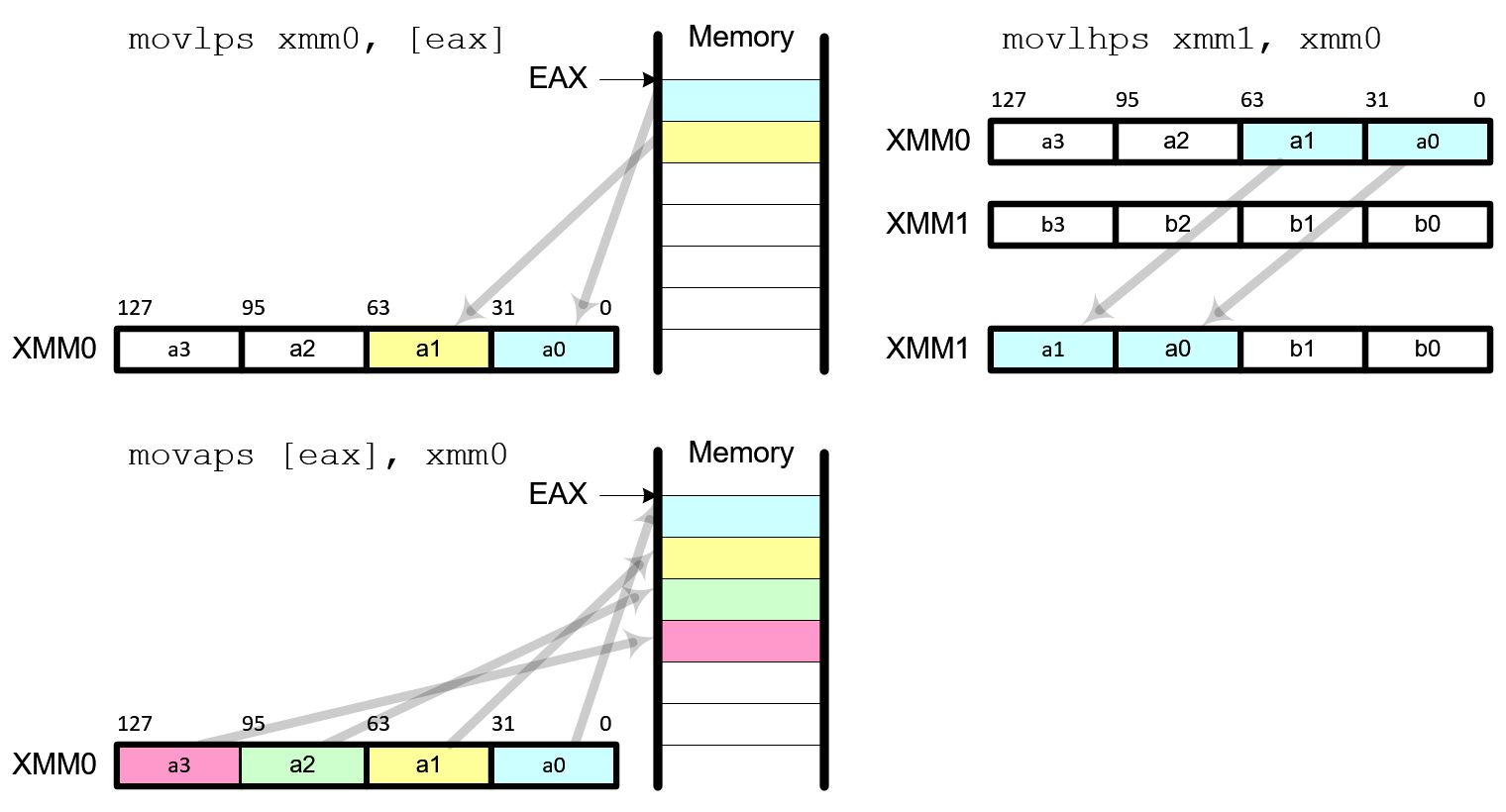
Arithmetic Instructions
Arithmetic Instruction requires 2 operands (registers or memory) to perform arithmetic computation and write the result in the first register. The source operand can be xmm register or memory, but the destination operand must be xmm register.

| Arithmetic | Scalar Operator | Packed Operator |
|---|---|---|
| addss | addps | |
| subss | subps | |
| mulss | mulps | |
| divss | divps | |
| rcpss | rcpps | |
| sqrtss | sqrtps | |
| rsqrtss | rsqrtps | |
| maxss | maxps | |
| minss | minps |
Shuffle Instruction
shufps requires 2 operands and 1 mask. shufps selects 2 elements from each operand (register) based on the mask. 2 elements from the first operand are copied to the lower 2 elements in destination register and 2 elements from the second operand are copied to the higher 2 elements in the destination register.
Using shufps instruction, you can shuffle any 4 data elements with any order. The frequent usages of shufps are broadcast, swap and rotate.
Broadcast
It copies all 4 fields with a single data element. The possible masks are
00h: Broadcast the least significant data element
55h: Broadcast the second data element
AAh: Broadcast the third data element
FFh: Broadcast the most significant data element

Swap
This instruction switches the order of data elements reverse with 1Bh (00011011b) mask.
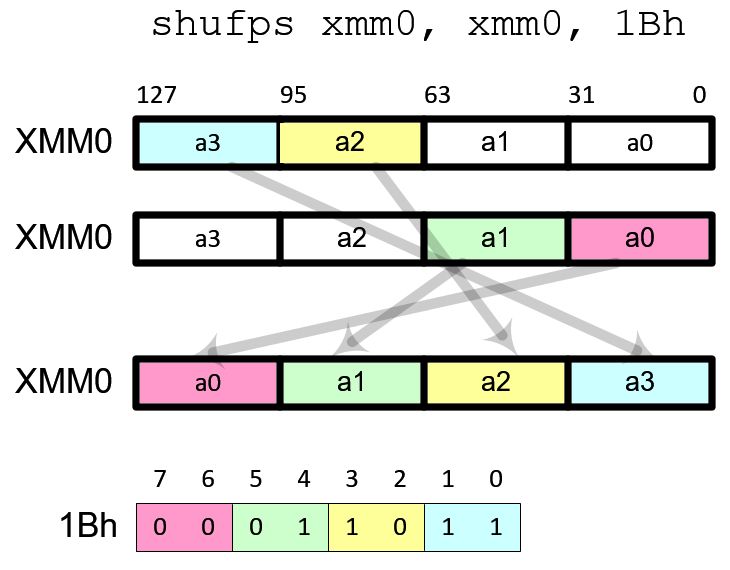
Rotate
It performs left or right rotation of data elements. Use 93h (10010011b) to shift data to left direction and the most significant data element is moved to the least significant position. Use 39h (00111001b) to shift data to right and the least significant data element is moved to the most significant position.
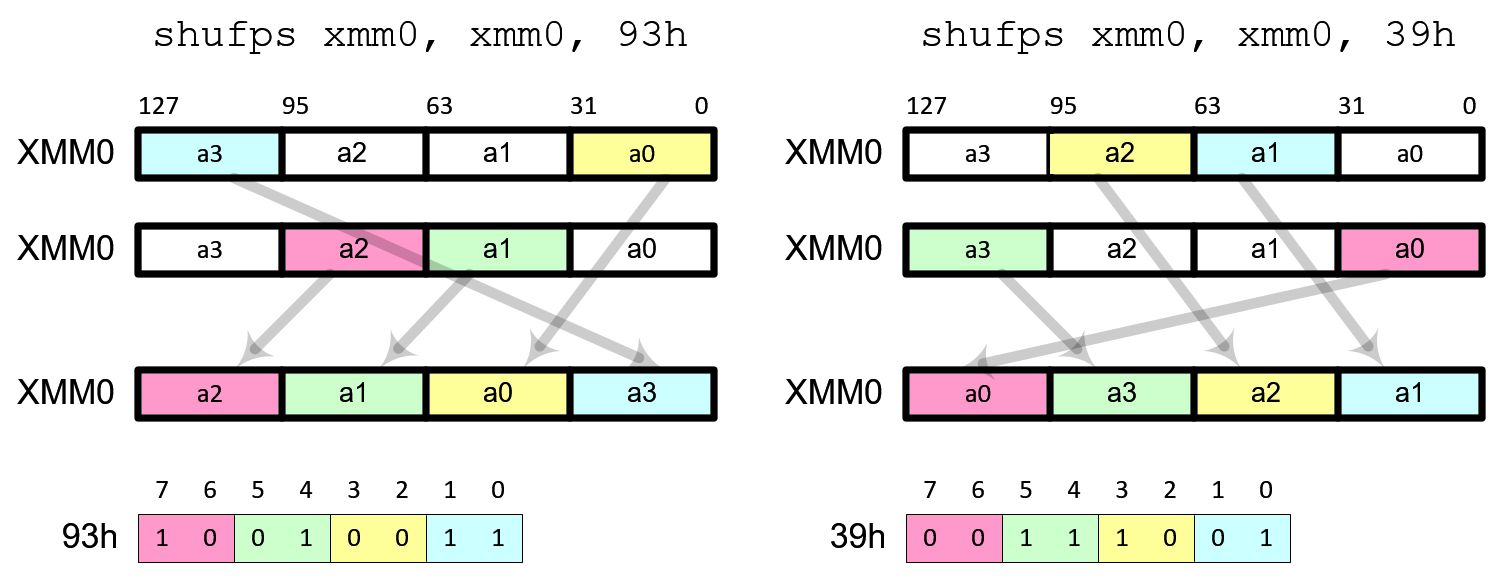
Unpack Instruction
unpcklps copies and interleaves the 2 lower elements from each of the 2 operands. unpckhps copies and interleaves the 2 higher elements from each of the 2 operands into the destination register.

Comparison Instructions
The comparison instructions compare 2 operands and set true (all 1s) or false (all 0s) into destination register. Source operand can be an xmm register or memory, but the destination must be an xmm register.
| Condition | Scalar Operation | Packed Operation |
|---|---|---|
| x = y, x ≠ y | cmpeqss, cmpneqss | cmpeqps, cmpneqps |
| x < y, x ≮ y | cmpltss, cmpnltss | cmpltps, cmpnltps |
| x ≤ y, x ≰ y | cmpless, cmpnless | cmpleps, cmpnleps |
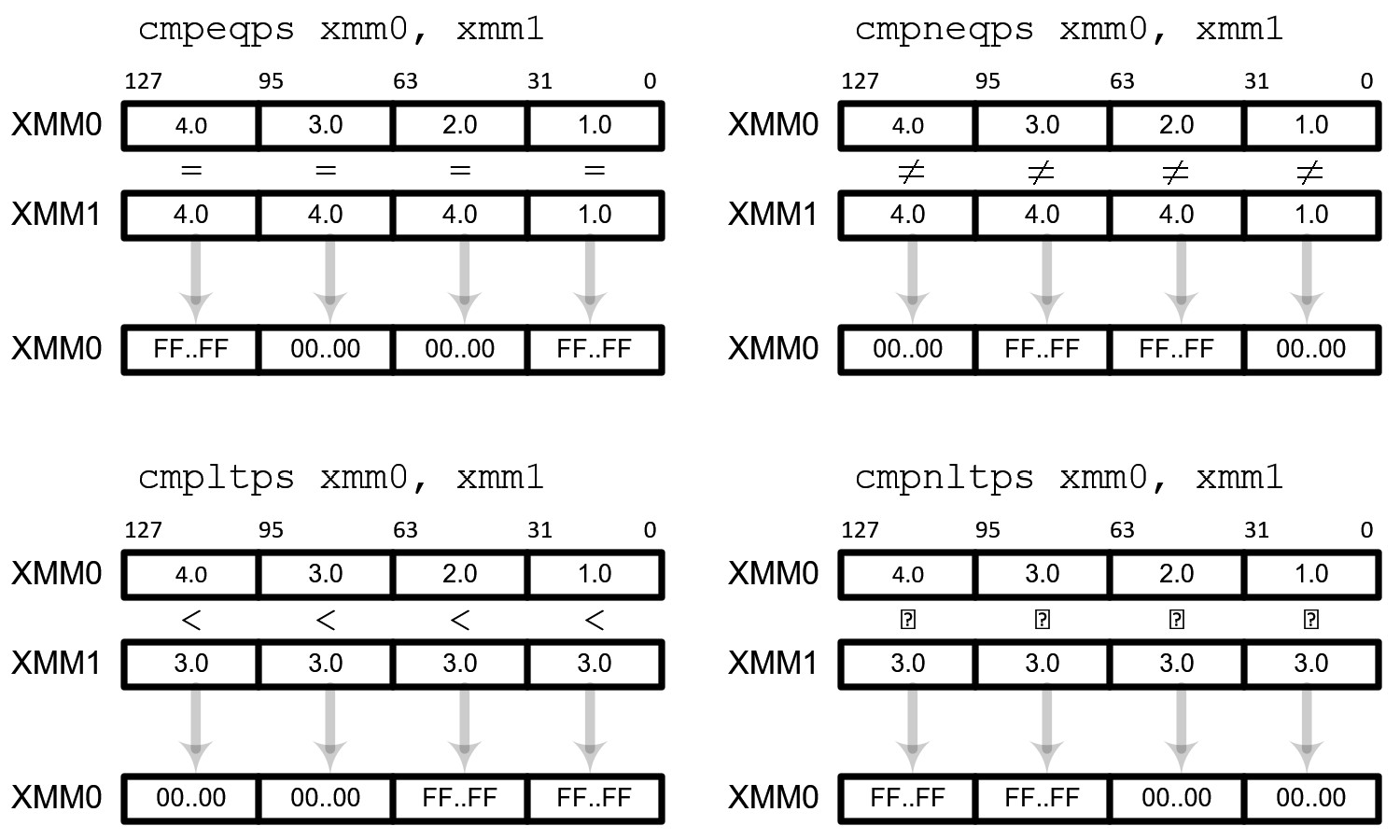
Bitwise Logical Instructions
Logical instructions perform bitwise logical operation on packed floating-point elements. The typical usages are negating numbers and converting to absolute values.
| Operation | Instruction |
|---|---|
| AND | andps |
| OR | orps |
| XOR | xorps |
| AND NOT | andnps |
Absolute Value
To perform absolute value operation, store 0 at the most significant bit (sign bit) and 1s at the rest bits in source register. Then perform AND operation: number & 7FFFFFFFh.
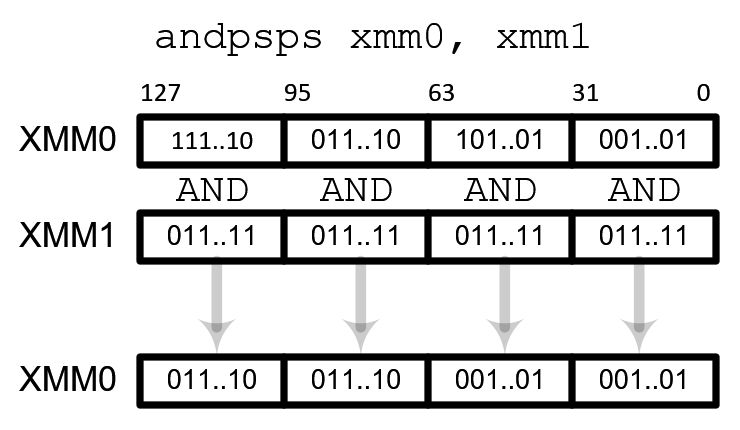
Negate
To perform negating, store 1 at the most significant bit and 0s at the rest bits. Then perform XOR operation: number ^ 8000000h.
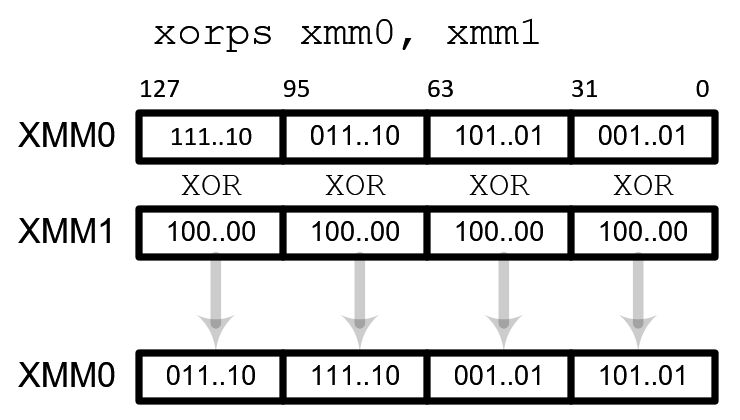
Conversion
Conversion instructions convert from floating-point number to integer or vise versa.
| Conversion | Scalar Operation | Packed Operation |
|---|---|---|
| Float to integer with rounding | cvtss2si | cvtps2pi |
| Float to integer with truncation | cvttss2si | cvttps2pi |
| Integer to float | cvtsi2ss | cvtpi2ps |
The packed operations, cvtps2pi, cvttps2pi and cvtpi2ps convert 2 numbers in parallel, not 4 because MMX registers (mm0~mm7) are 64-bit long (2x32-bit). Therefore, two upper elements in XMM registers are not used in conversion.
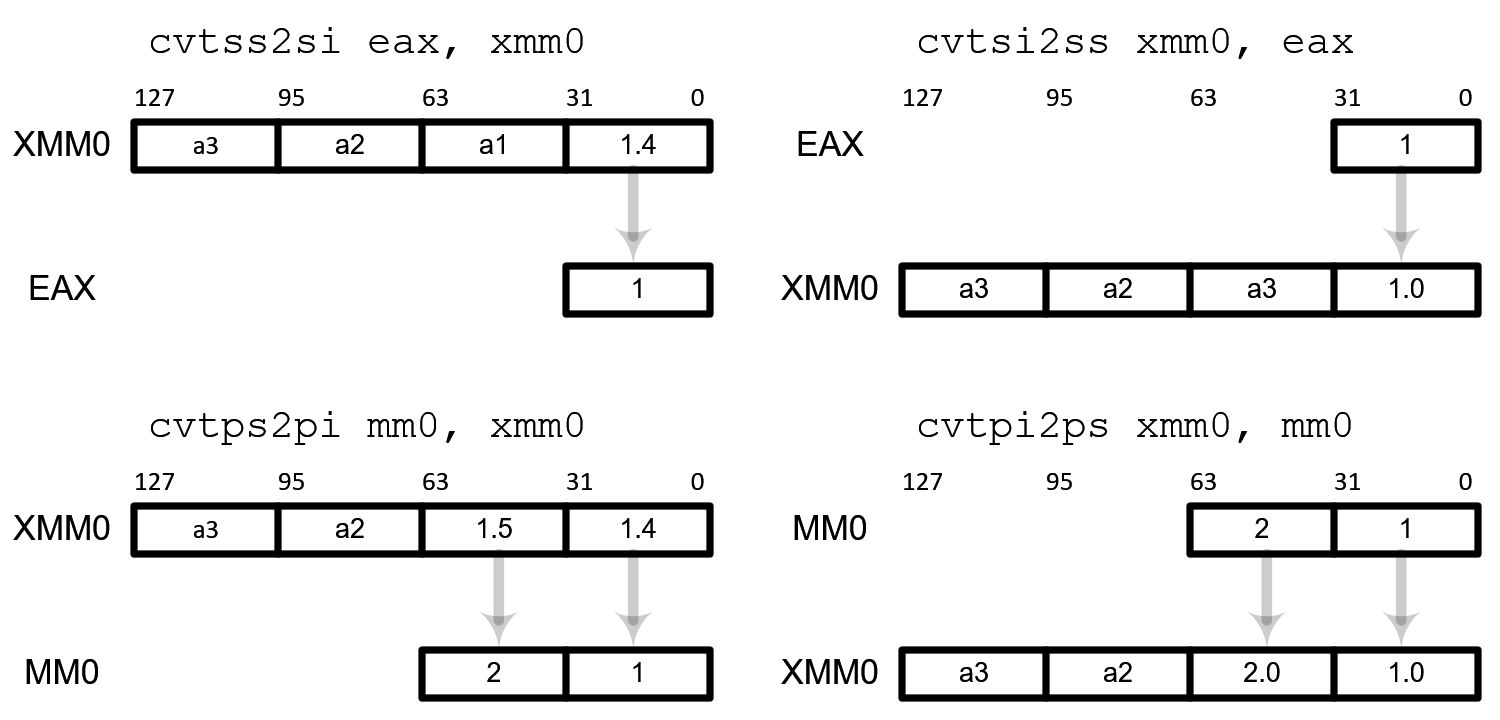
Streaming memory Instructions
SSE lets read-miss latency overlap execution via the use of prefetching, and it allowes write-miss latency to be reduced by overlapping execution via streaming stores.
Prefetch Instructions
The prefetch instructions provide cache hints to fetch data to the L1 and/or L2 cache before the program actually needs the data. This minimizes the data access latency. These instructions are executed asynchronously, therefore, program executions are not stalled while prefetching.
prefetcht0: move the data from memory to L1 and L2 caches using t0 hint.
prefetcht1: move the data from memory to L2 cache using t1 hint.
prefetchnta: move non-temporal aligned data from memory to L1 cache directly (bypass L2).
Note that AMD athlonXP, Intel Pentium4 or higher CPUs include automatic cache prefetching, therefore, it is not necessary to call these instructions manually in your code.
Streaming Store Instructions
Streaming store move instructions store non-temporal data directly to memory without updating the cache. This minimizes cache pollution and unnecessary bus bandwidth between cache and XMM registers because it does not write-allocate on a write miss.
Non-temporal means the data are accessed irregularly at long intervals (referenced once and not reused in immediate future) , for example, vertex data in 3D graphics are re-generated every frame.
Write-allocate means that data write into the cache when cache miss occurs.
movntps: move 4 of non-temporal floating-point elements from XMM register to memory directly and bypasses the cache. The memory address must be aligned 16-byte boundaries.
movntq: move non-temporal quadword (2 integers, 4 shorts or 8 chars) from XMM register to memory and bypasses the cache.
movntps [edi], xmm0
movntq [edi], mm0
Store Fence
sfence guarantees that the data of any store instructions earlier than sfence instruction will be written to memory before any subsequent store instruction.
The following inline assembly example shows copying 4 float data (16-byte block) at once from source to destination array.
// move 4 floats (16-bytes) at once
__asm {
mov ecx, count // # of float data
chr ecx, 2 // # of 16-byte blocks (4 floats)
mov edi, dst // dst pointer
mov esi, src // src pointer
loop1:
movaps xmm0, [esi] // get from src
movaps [edi], xmm0 // put to dst
add esi, 16
add edi, 16
dec ecx // next
jnz loop1
}
Detecting SSE support
cpuid instruction can be used whether the processor supports SSE or not. Most x86 processors support cpuid instruction nowadays, which returns CPU information and supported features. In order to determine your CPU supports cpuid instruction, try to toggle(modify) bit 21 in EFLAGS. If bit 21 can be toggled, cpuid can be called.
Calling cpuid with eax=01h returns standard feature flags to the edx register. SSE is supported if bit 25 (26th bit from the least significant bit) of edx register is 1. In addition, bit-26 is for SSE2 support and bit-23 is for MMX support.
This is a very simple program to detect SSE support and other features: cpuid_msvc.zip.
(Note that this program uses MSVC specific inline assembly codes in it.)
Example of Inline Assembly
The following program is an example of SSE usages in MSVC inline assembly. It includes example codes of all above SSE instructions.
Download the source and binary: sse_msvc.zip